With a journey in mythology begins the wonderful book Εδεσματολόγιον Θεσσαλίας by Efi Grigoriadou that was sent to us by Savalas Publishers, and it is full of historical information, customs and traditions. From the gods of Olympus it reaches the Centaurs and the Argonauts. It traverses the history of Thessaly and focuses on individual characteristics, customs and traditions. In our new article we will search for the mosaic of people and tribes that lived in Thessaly, as well as the eating habits that characterize this area, with the help of the book Εδεσματολόγιον Θεσσαλίας. With a recipe of the book we will make batzina, a local, traditional pie with feta cheese.



In the book, Thessaly is called a mythical and historical place… Homeland of Asclepius, father of Medicine, Latins and Centaurs, it was the birthplace of saints, teachers of the Nation, kleftes and armatoloi of the Greek Revolution, it was also the homeland of Rigas, Karaiskakis, Gazis, poets, sculptors, musicians, painters hagiographers, people of Letters and Arts…

As we read in the Εδεσματολόγιον Θεσσαλίας the different groups of people that consist Thessaly maintain their traditions, music and dances. In the mountains there are Vlachs, Sarakatsani and Haniotes, in the plain Karagounides and in the coastal areas of Thessaly people who behave like islanders.
The Vlachs have a history of at least 2000 years with roots in the Roman years and the Eclatinization of the Balkans. The contribution of the Vlachs to Hellenism is huge in all areas. Prominent personalities, such as Rigas Velestinlis, but also the benefactors Zappas, G. Stavrou, Averof, Sina, Doumpas, Tositsas, Stournaras, Koletis, Sp. Lambrou, Papagos, Svolou, Krystallis and others with their donations supported the newly established state.

The Vlachs are the first bilingual Greeks who, during the years of the Roman Empire, also learned Latin, due to their cooperation with Roman troops for twenty years in the campaign of Trajan. As we have learned, the Vlach language is an autonomous Neo-Latin language, already formed from the 6th c. A.D. Elsewhere we read that it belongs to the branch of Roman languages, the idiomatic forms produced by Latin after the fall of the Roman Empire. Vlach language is for the most part a spoken language.

The Karagounides, ie the inhabitants of the lowland areas of Thessaly are considered direct descendants of the first inhabitants of the area. Adapting their daily life, work and fun to the conditions of the plain and rural life, they made their own traditions, dances and songs. We learned that the Karagounides spoke a linguistic idiom with a variety of idiomatic elements.

The Sarakatsani are an ancient Greek race. They were nomadic herders without their own land and residence. They were dominant in the mountains of Pindos, where the Greek language was first introduced. According to linguistic data, the language of the Sarakatsani was and is only Greek. The Sarakatsani had a great contribution to the Revolution of 1821 and to the Macedonian Struggle. After the end of World War II, the Sarakatsani abandoned the nomadic way of life, as well as the semi-nomadic way of life in recent decades.

These population groups coexisted in Thessaly, maintaining their cultural identity with their habits, costumes, dances and language. Especially with regard to language, minority language varieties are studied by the scientific branch of Sociolinguistics, with the aim of preserving linguistic diversity. For modern linguists there are no upper and lower languages, nor complete and incomplete languages. They are all equal, with their distinctive characteristics and should not get lost.
Back to our book now … The book Εδεσματολόγιον Θεσσαλίας is organized based on the months of the year. In Thessaly, the last month of winter, February found the mountainous and several of the lowland areas covered with snow. It was a difficult month for the Karagounis due to the bitter cold and the bad living conditions. But it was the month in which the first plowing took place. On February 1, on the feast of St. Tryphon, the patron saint of vines, the vine growers went to church with a bottle of wine. After the service, the priest blessed the wines with which they sprinkled their vines.

The plain. Winter is sad. Summer Hell. Autumn envelops him in very charming melancholy. Ιn spring, nothing can be compared to the plain of Thessaly. You have to start at dawn, when Ossa is decorated with roses at sunset.
When the snows of Olympus still hold the stern blue veils of the night on them, before even, in the first rays, the low white pure that dissipates along the rivers, the ditches, the swamps dissolves…
M. Karagatsis, excerpt, Εδεσματολόγιον Θεσσαλίας
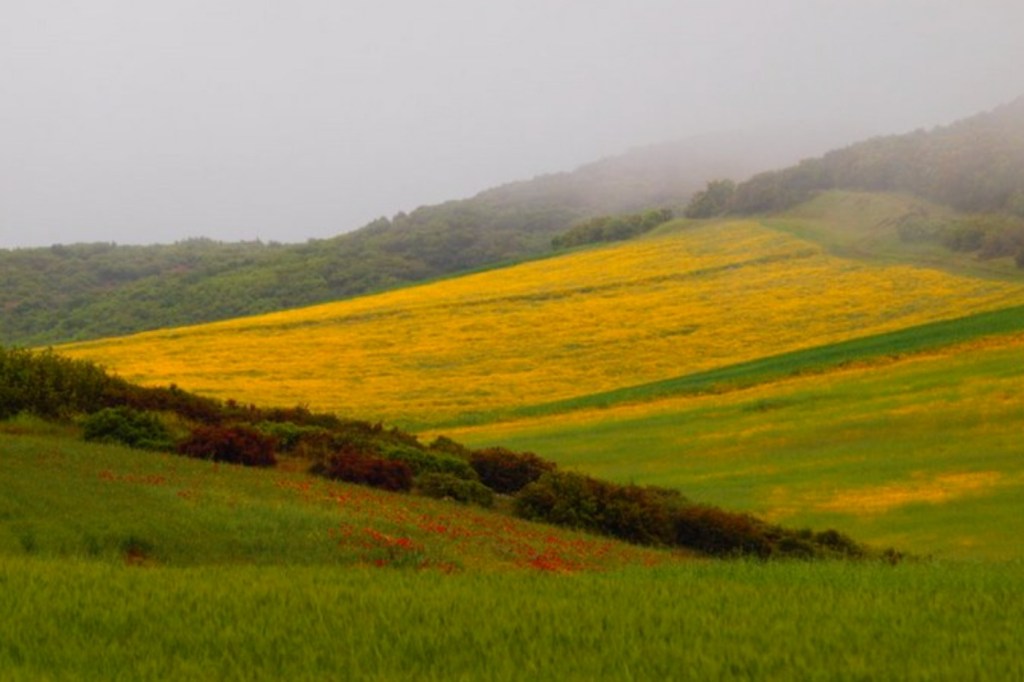

In ancient times the inhabitants of Thessaly were considered gourmets. Later their diet was organized based on the cycle of the seasons, the geographical location, the products available, the customs and the fasts, which were reverently kept by the inhabitants of the area. The Thessalians were mainly engaged in the cultivation of land and cereals. Another staple of the area was dairy products, and of course bread and their famous pies. Depending on the season, the filling of the pie changed, from trachanopita in winter to pumpkin pie in summer. Livestock was developed in Thessaly, but it was about dairy products and less for meat that they did not eat often. They moreover ate fish from the beach of Volos, but also from lakes and rivers. The most common diet, however, was legumes and vegetables, since the Thessalians fasted a lot and these products cost little money. For dessert they ate fruits and nuts, but also sponge cake, moustalevria, quince paste, pancakes, baklava and pastries.

So let’s see some typical, sweet and savory recipes of Thessaly.





Baking bread
In the oven of the yard, the women first threw the dry branches and a couple of large logs. As soon as they burned well and ignited the whole surface of the oven, they pulled the coals out and with a stick, with a wet cloth tied to its edge, cleaned the oven thoroughly, placed the loaves on a boards for the oven, made a cross and baked them. As soon as the breads turned brown, they sprinkled them with a little water to polish them and waited for them to be baked.
Εδεσματολόγιον Θεσσαλίας


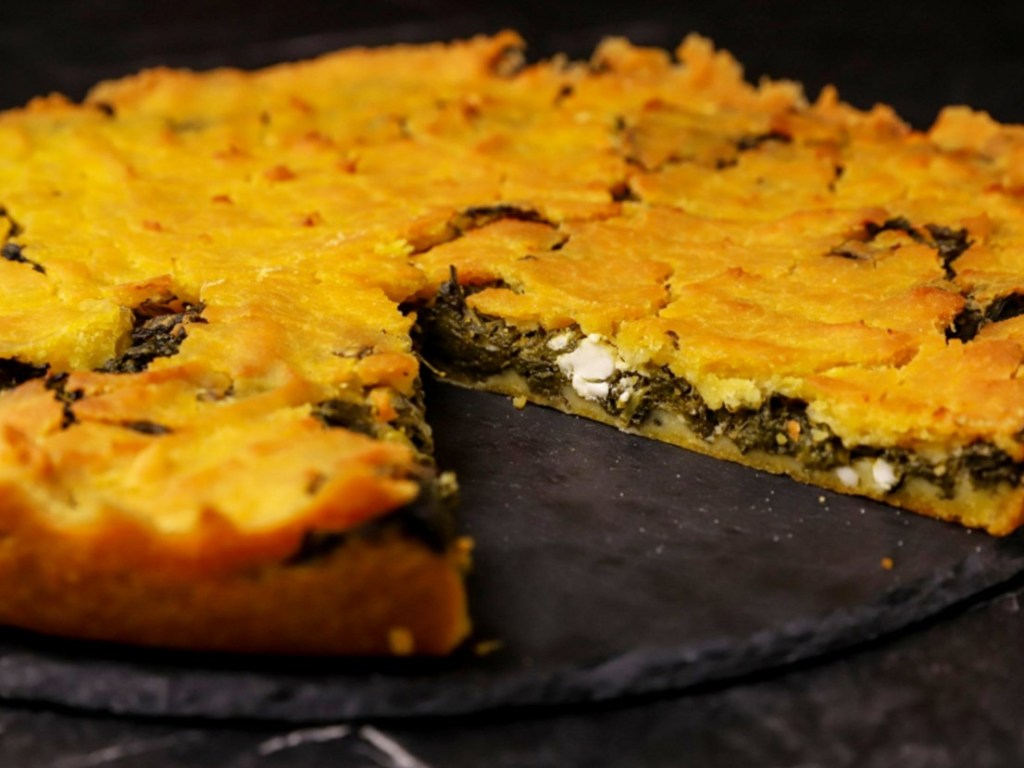



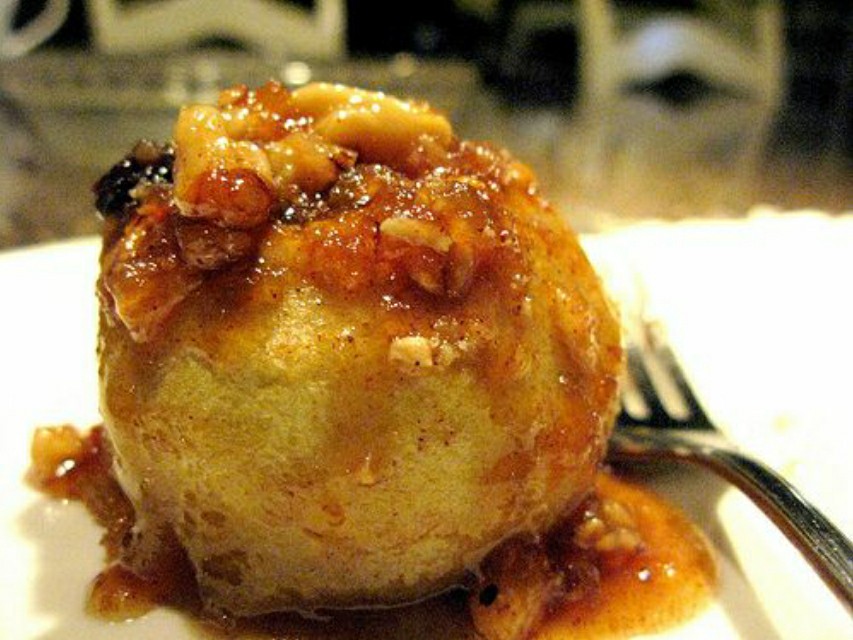

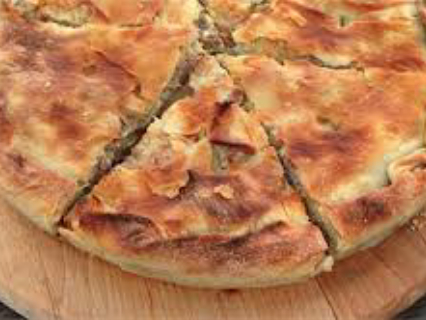
And now that we have built an appetite for the good, it’s time to make our own Thessalian pie.
Batzina

* We translate the recipe as it is included in the book.
Ingredients
| Milk | 2 cups |
| Fresh yeast | 25-30 gr |
| Grated feta cheese | 250 gr |
| Eggs | 2 |
| Flour | 3 cups (approximately) |
| Βutter | for the pan |

Execution
Dissolve the yeast in a little lukewarm milk. Pour the rest of the milk into a bowl and mix it with the dissolved yeast. Add the eggs, the cheese and finally the flour. Mix the ingredients well to form a uniform porridge. Grease a pan, pour in the porridge and let it stand for 10-15 minutes in a warm place to rise. Finally, sprinkle the porridge with a little milk and its surface with a little grated cheese. Bake the batter in a preheated oven at 200°C for about 50 minutes until golden brown.




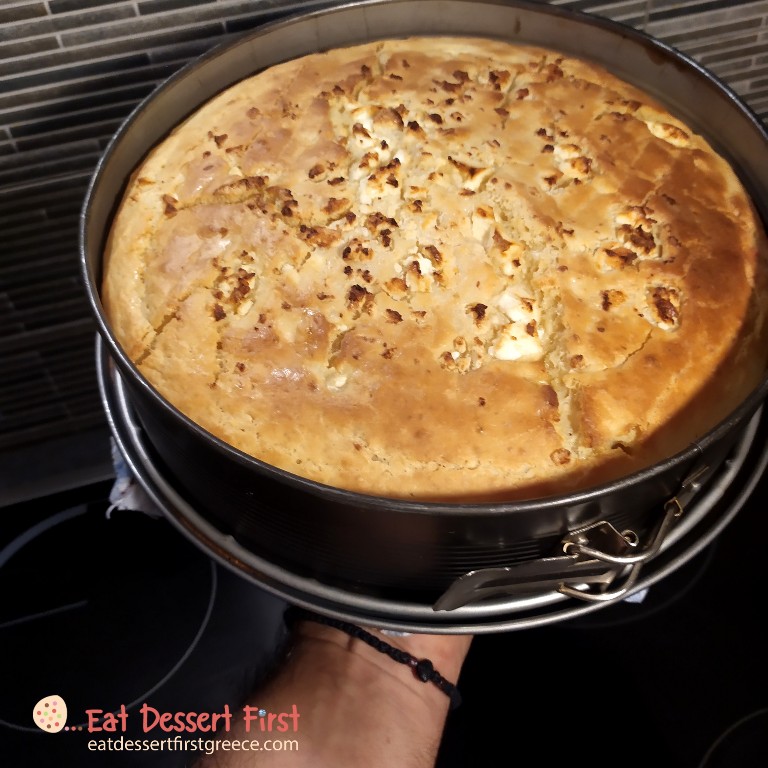
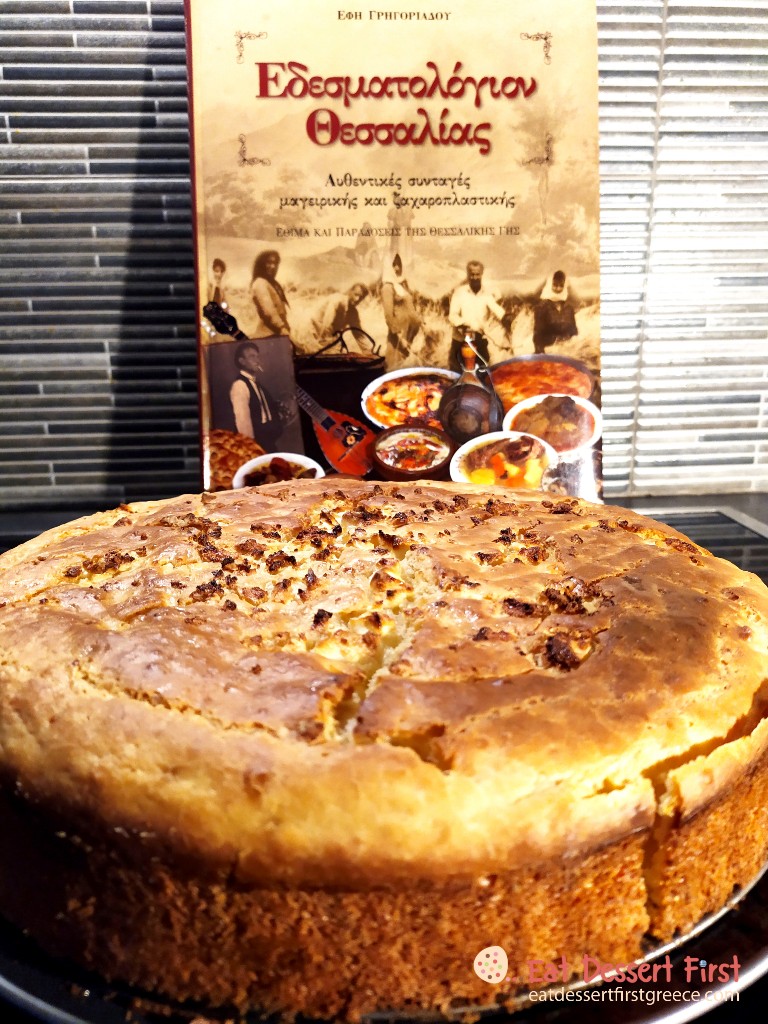
You must try the recipe, it is easy and the result is impressive! Good savory creations to aĺl!
Be the first one to read our new articles!
Find us on our social media:
- Instagram: @eatdessertfirstgreece
- Facebook profile: Giorgos Eliza Vlachakis
- Facebook page: eatdessertfirstgreece
- Twitter: @eatdessert1stGr
- Pinterest: eatdessert1stGr
- WordPress: Eat Dessert First Greece
- LinkedIn: Eliza Neofytou
- Reddit: eatdessertfirstgr
Follow us by filling in your email in the field at the bottom of our website, so that every new article will be emailed to you as soon as it is released. Do not forget to confirm your registration, in the email that will come to you! 🤗 Those of you who are wordpress bloggers, just click follow.







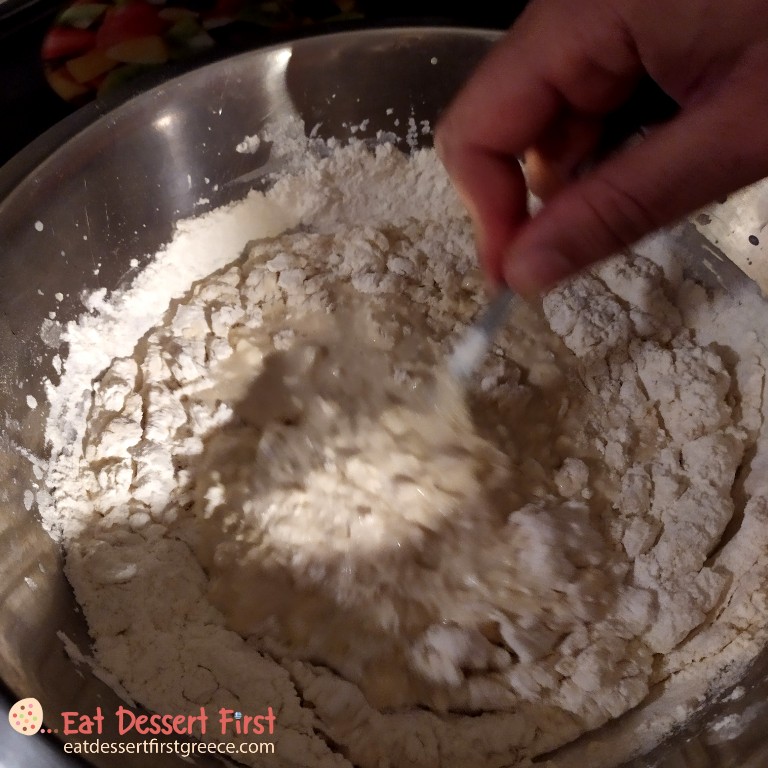



This was a really interesting post. If you ever feel like sharing a recipe for moustalevria, that would be fantastic 🙂
LikeLike
Thank you very much dear friend Aspasia , you like moustalevria very much and we think that writing an article about moustalevria is wonderful idea! 🙏🙏🌷🌷🌷
LikeLiked by 1 person
I’m excited to read it 🙂
LikeLiked by 1 person
What delicious food!
LikeLiked by 1 person
Thank you so much our dear friend Mrs Diane!!!
LikeLiked by 1 person
You’re very welcome!
LikeLiked by 1 person
Great site, used to live in Greece so it makes me nostalgic!
LikeLiked by 1 person
Thank you so much for your kind comment and for loving our country! 🌹🌹🌹
LikeLike
I acted in Greek comedy loufa Kai paralagi?
LikeLike
This is great! It is a famous movie in Greece! I find you in IMDB, congratulations and nice to meet you dear friend! ☺️☺️
LikeLike
Yes lovely to meet you too.
LikeLiked by 1 person
🙏🙏❤️❤️
LikeLike
Thank you so much our dear friend Sally! 🙏🙏🌺🌺🌺🌺
LikeLike
This looks and sounds delicious..when you put your mix into a preheated oven for 15 mins at what temperature and do you leave the oven on and what size cake pan mine is 9 inch 🙂
LikeLike
Thank you so much for the kind comment! You put the mixture in a closed oven just to let it rise and then you turn the oven on. Any size cake pan will do, it will just become higher! Greetings from Greece!
LikeLiked by 1 person
Thank you for responding to my query…Have a nice day 🙂
LikeLiked by 1 person
🙏🙏🙏🌹🌹🌹
LikeLike
Thank you for sharing this very interesting information. The cheese pie recipe is also wonderful. Have a nice week! Michael
LikeLike
Thank you very much for commenting! Have a nice week you too!
LikeLiked by 1 person